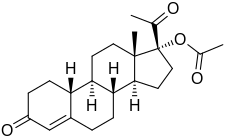Gestonorone acetate
 | |
| Clinical data | |
|---|---|
| Other names | Gestronol acetate; Norhydroxyprogesterone acetate; 17α-Hydroxy-19-norprogesterone 17α-acetate; 17α-Acetoxy-19-norprogesterone; 17α-Hydroxy-19-norpregn-4-ene-3,20-dione 17α-acetate |
| Drug class | Progestin; Progestogen |
| Identifiers | |
| |
| CAS Number | |
| PubChem CID | |
| ChemSpider | |
| CompTox Dashboard (EPA) | |
| ECHA InfoCard | 100.046.242 |
| Chemical and physical data | |
| Formula | C22H30O4 |
| Molar mass | 358.478 g·mol−1 |
| 3D model (JSmol) | |
| |
| |
Gestonorone acetate, or gestronol acetate, also known as norhydroxyprogesterone acetate, is a progestin of the 19-norprogesterone and 17α-hydroxyprogesterone groups which was developed in the early 1960s but was never marketed.[1][2][3][4][5][6][7][8][9][10][11][12][13][14] It is the C17α acetate ester of gestronol (17α-hydroxy-19-norprogesterone).
Gestonorone acetate has been found to consistently inhibit ovulation at an oral dosage of 10 mg/day in combination with 50 μg/day oral ethinylestradiol.[15] Weak or no endometrial effects were observed at an oral dosage of 100 mg/day, basal vacuoles appeared at 130 to 140 mg/day, and full endometrial secretory transformation occurred at 220 mg/day.[16]
See also[]
References[]
- ^ Noguchi, Shunsaku (1961). "Steroids. XX. Hydrolysis of steroidal esters by malt enzyme. 1. Selective hydrolysis of steroidal acetates". Yakugaku Zasshi. 81 (3): 369–373. doi:10.1248/yakushi1947.81.3_369. ISSN 0031-6903.
- ^ Noguchi, Shunsaku (1961). "Steroids. XXIII Hydrolysis of steroidal esters by malt enzyme. 4. Synthesis of 17α,19-dihydroxyprogesterone and 17α-hydroxy-19-norprogesterone". Yakugaku Zasshi. 81 (3): 381–384. doi:10.1248/yakushi1947.81.3_381. ISSN 0031-6903.
- ^ Dorfman, R; Kincl, F (1963). "Steroid anti-estrogens". Steroids. 1 (2): 185–209. doi:10.1016/S0039-128X(63)80136-1. ISSN 0039-128X.
- ^ Suchowsky GK (April 1963). "Pregnancy-maintaining effect of synthetic progestogens in the rat". Acta Endocrinol. 42 (4): 533–6. doi:10.1530/acta.0.0420533. ISSN 0001-5598. PMID 13979052.
- ^ Kalvoda, J; Heusler, K; Anner, G; Wettstein, A (1963). "Steroids. CXCVI. 19-Norsteroids. III. Synthesis of 19-norprogesterones". Helvetica Chimica Acta. 46: 1017–1029. doi:10.1002/hlca.19630460332. ISSN 0018-019X.
- ^ Junkmann, K (1963). "Evaluation of synthetic gestagenic substances". Deutsche Medizinische Wochenschrift. 88 (13): 629–638. doi:10.1055/s-0028-1111990. ISSN 0012-0472. PMID 13958089.
- ^ Kincl, Fred A.; Dorfman, Ralph I. (1963). "Orally active steroidal ovulation inhibitors in the adult estrus rabbit". Steroids. 2 (5): 521–525. doi:10.1016/0039-128X(63)90029-1. ISSN 0039-128X.
- ^ Suchowsky, GK (1963). "Inhibition of ovulation by steroids". Journal of the Egyptian Medical Association. 1962–1963: 67–73. ISSN 0013-2411.
- ^ Junkmann, K (1962). "The pharmacology of new gestational and anabolic steroids". Deutsch-Englische Medizinische Rundschau. 1 (4): 385–399. ISSN 0003-3332.
- ^ Suchowsky GK, Baldratti G (September 1964). "Relationship Between Progestational Activity and Chemical Structure of Synthetic Steroids". J. Endocrinol. 30 (2): 159–70. doi:10.1677/joe.0.0300159. PMID 14207040.
- ^ Nevinny-Stickel J (1964). "Inhibition of ovulation determined by estimation of pregnanediol excretion". Int. J. Fertil. 9: 57–67. PMID 14106269.
- ^ Jung, H; Peters, A (1967). "Effect of various gestagens on the fetal development and death rate in animals". Archiv für Gynäkologie. 204 (1): 68–77. doi:10.1007/BF00668265. ISSN 0003-9128. PMID 5630697. S2CID 22416963.
- ^ Gilbert, H.G.; Phillipps, G.H.; English, A.F.; Stephenson, L.; Voollett, E.A.; Newall, C.E.; Child, K.J. (1974). "The progestational and anti-estrogenic activities of some novel 11β-substituted steroids". Steroids. 23 (4): 585–602. doi:10.1016/0039-128X(74)90010-5. ISSN 0039-128X. PMID 4829347.
- ^ Tang, Rui-ren; Guo, Can-cheng; Fan, Bo-lin (2004). "Stereoselective asymmetric synthesis and characterization of 17α-acetyoxy-19-nor-progesterone". Journal of Central South University of Technology. 11 (3): 300–303. doi:10.1007/s11771-004-0061-y. ISSN 1005-9784. S2CID 195244927.
- ^ Gregory Pincus (3 September 2013). The Control of Fertility. Elsevier. pp. 222–. ISBN 978-1-4832-7088-3.
- ^ Nevinny-Stickel, J. (1962). "Die gestagene Wirkung von Hydroxy-nor-Progesteronestern bei der Frau". Gewebs- und Neurohormone [The progestational effects of hydroxy-nor-progesterone esters in women]. pp. 248–255. doi:10.1007/978-3-642-86860-3_27. ISBN 978-3-540-02909-0.
Nach oraler Verabreichung von 100 mg des Hydroxy-nor-ProgesteronAcetats sah man nur schwache oder noch keine gestagene Wirkung am Endometrium (Abb. 3). Nach der oralen Dosis von 130- 140 mg traten basale Vacuolen auf, nach 220 mg war - außer bei einer Patientin mit individuell geringerer Ansprechbarkeit des Endometriums (2) - eine volle sekretorische Umwandlung erreicht: [...]
Categories:
- Abandoned drugs
- Acetate esters
- Diketones
- Norpregnanes
- Progestogen esters
- Progestogens
- Steroid stubs
- Genito-urinary system drug stubs